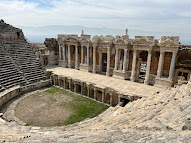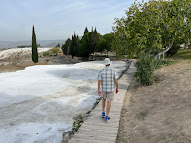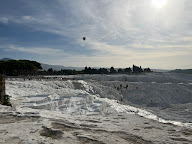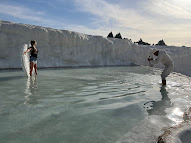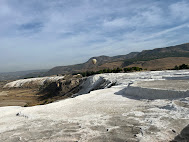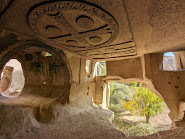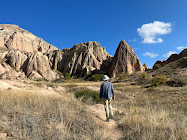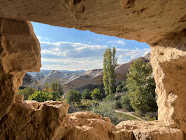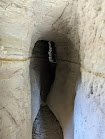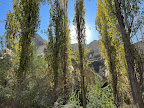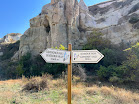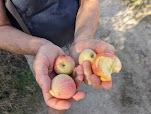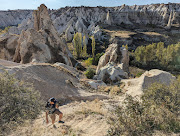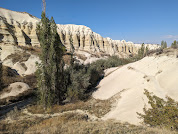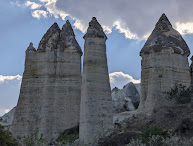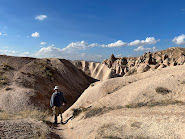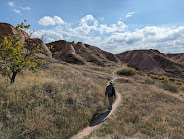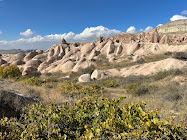Motivation ~ Itinerary and Tips ~ Plants and Patterns


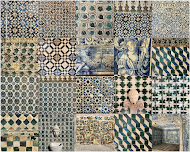
Left: A mosaic of plants seen during three days in Sintra, Portugal.
Center: A mosaic of architectural features in Sintra, Portugal.
Right: Tiles from the Sintra National Palace.
Motivation
When studying for a possible visit to Sintra, it became obvious to us that one day would not be enough given our slower travel style. So, we dedicated 3 days (stayed 3 nights). It was perfect.
Itinerary and Tips
- Day 0: arrive late afternoon, check in, walk the town a bit.
- Day 1: Castelos dos Mouros (Castle of the Moors), Palácio da Pena (Pena Palace), late lunch.
- We spent the day walking. Walk to Castelos dos Mouros (entered at Rampa do Castelo) , then Pena Palace, and then back to Sintra via the Vila Sassetti trail.
- Day 2: Palácio de Monserrate (Monserrate Palace), lunch, and Quinta da Regaleira.
- We took a Tuk Tuk to Monserrate and then bus 435 back to station. From the station, the next bus was more time than it took to walk to Quinta, so we walked.
- Day 3: Palácio de Sintra (Sintra National Palace), lunch, depart.
- We stayed across the street in Sintra Flower Lux apartments.
Our favorite stop was Monserrate because there were way fewer people, the house was fun to visit, and the gardens spectacular. Our least favorite was Quinta. The Sintra National Palace was a very calm and relaxing experience. Get the audio guide on your phone, it’s worth it.
At Pena Palace, your ticket is timed for entry into the castle, not the garden and areas around the castle. So, enter early if you want. Entry into the castle for your time slot could still take some time. We shuffled through a line for 20+ minutes before entering the castle and then inside, we were constrained to walk single file for the first part of the visit, and spaces are tight. It’s a pity because it takes away from the experience. Hang back in your time slot and the crowd should thin out.
We thought the Chalet of the Countess of Edla (on the Pena Palace ticket and located in the vast garden) was perhaps more intriguing than the palace, because there were less people, more time to explore on your own. Don’t miss it.
Some other tips that might help:
- Figuring out the bus. Arggh...we were so silly.
- Because the roads are one way, you must factor in that you may be returning to the station (where the buses start) to get to another site that seems close by. It took us a bit to figure that out. The main buses are 434 and 435 and go in loops.
- Google maps doesn’t seem to know about these routes.
- We downloaded the ScottUrb app but it wasn’t working and proved useless. You just wait until the bus comes. You can pay on the bus.
- Take a Tuk Tuk to save time, at least once for the fun of it. Negotiate the price or at least don’t accept willingly the first price they might throw out.
- You can store luggage at the very nice Loja Tradições - Artesanato e Depósito de Bagagem - across from the train station. Super nice people and easy storage.
- Places we ate breakfast at:
- Café Saudade was the best followed by the nearby Larmanjat. Both of these places are near the station.
- Café Paris in the historical center is overpriced and a bit shabby though with nice location.
- Fábrica da Nata – stopped twice here to get a pastel de nata.
- Places we ate and liked for lunch:
- Places we ate at and liked for dinner:
- Romaria de Baco (ate here twice we liked it so much)
- Bacalhau na Vila
- Take a trip to visit Palazzo Nazionale di Quelez. Likely would be a taxi ride.
- Take a trip to the coast just under 10 km away as the crow flies.
- Visit the Museu Anjos Teixeira - right in the center of Sintra.
- Visit the Palácio e Parque Biester - near La Regaleira.
- Stroll through Parque da Liberdade – in the center of Sintra.
- Heck, even take a day trip to Lisbon, the reverse of what everyone else does.
Plants and Patterns
We figured this out: first, it was the plants that we saw during our stay. To understand the plants, you must understand the climate. The climate in Sintra, Portugal in general is mild, warm and temperate, and is greatly influenced by the Atlantic Ocean. On the widely used Köppen-Geiger climate classification system, Sintra is rated as “Csb”. The Csb classification is a subtype of the Mediterranean climate, characterized by dry and warm summers, and mild and rainy winters. The summers in Sintra have day temperatures ranging from 14 °C (57 °F) in January to 24 °C (75 °F) in August. The winters are cold, wet, and partly cloudy, with temperatures ranging from 48°F to 79°F.
When we arrived, it was a foggy Sunday afternoon in mid-November. Such as mysterious welcome to Sintra. (Our plane was delayed due to fog.) Then the next few days it was sunny, breezy, and pleasant.
In the Sintra climate, there are lots of plants that we love! We felt at home...like a little bit of Seattle, a little bit of California, a little bit of Italy.
A good example of the range of plants in the gardens of Monserrate Palace, which were the most pleasant that we experienced. (Here’s a tree finder for that garden.) Here are just a few of the genus names you’ll see at Monserrate and around Sintra:
Abies, Acacia, Acer, Aesculus, Albizia, Aloe, Araucaria, Arbutus, Archontophoenix, Aucuba, Beaucarnea, Brachychiton, Brahea, Brugmansia, Buddleja, Camellia, Castanea, Cedrus, Cephalotaxus, Cercis, Chamaecyparis, Cinnamomum, Cordyline, Cryptomeria, Cupressus, Cyathea, Dicksonia (tree fern), Diospyros, Dracaena, Encephalartos (cycad), Erica, Eucalyptus, Fagus, Ficus, Fraxinus, Ginkgo, Howea, Hypericum, Ilex, Jubea, Juniperus, Laurus, Livistona, Magnolia, Mahonia, Metrosideros, Monstera, Myrtus, Nerium, Olea, Osmanthus, Persea, Phoenix, Pinus, PIstacia, Pittosporum, Platanus, Podocarpus, Populus, Prunus, Pyracantha, Quercus, Rhododendron, Salix, Schinus, Sequoia, Sorbus, Strelitzia, Syzygium, Taxodium, Thuja, Tilia, Trachycarpus, Tsuga, Ulmus, Viburnum, Washingtonia, Wisteria, Yucca, Zelkova.
These plants come from all over the world and give a sub-tropical feel to Sintra. We can judge our own interest in plants by how many pictures of plants we are moved to take when visiting a place. Over our three days in Sintra, we took a lot of photos of plants because the specimens, the forms, the colors were so interesting.
The second major ah-ha moment of why this trip felt so fresh for us, were the patterns we saw. Here, we mean patterns in architecture, and we include decoration with that. Portuguese architecture is characterized by a variety of styles, such as Romanesque, Gothic, Manueline, Baroque, and Modern. Sintra is famous for its 19th-century European Romanticist architecture, historic estates and villas, gardens, and royal palaces and castles. There is a pastiche of styles from the rich, the royal, and the romantics, drawn to the area for its beauty and eager to make real their ideas of European Romantic architecture. Today, the historical center of the Vila de Sintra is classified as a UNESCO World Heritage Site.
European romantic architecture is a style of architecture that emerged in the late 18th and early 19th centuries, inspired by the artistic and literary movements of the Romantic era. It is characterized by a variety of forms, materials, and colors, often influenced by local traditions and landscapes. Some of the features of European romantic architecture include asymmetrical shapes, curved lines, ornamental details, towers, spires, domes, arches, and Gothic elements. The influence of the Moors – who ruled over Portugal for centuries – also plays a significant part in the architecture and decoration of some of the palaces.
In the Palace of Monserrate, we saw a reference to the book “Grammar of Ornament” by Owen Jones (1809 – 1874), a British architect. The book, first published in 1856, shows ornamental designs and patterns from vastly different eras, places, and cultures, including Assyrian, Greek, Byzantine, Turkish, Chinese, Celtic, Medieval, Islamic, and Renaissance. Jones wanted to improve the taste of contemporary designers by revealing the universal design principles that lay behind all historical ornamentation. It wouldn’t be a wild guess (and if I remember we saw explicit references of this) to say that Owen’s book informed the rebuilding of Monserrate in the second half of the 18th century by its new owner, the British merchant and art collector, Francis Cook (1817 – 1901).
The romantic sensibility is also on full display at the Chalet of the Countess of Edla (in the Pena Palace Park), built between 1864 and 1869.
Less Romantic but equally fascinating is the Sintra National Palace. We include a mosaic of tile patterns we saw in the Sintra National Palace. The colors and patterns – admittedly not a huge selection – were beautiful to look at.
The two large cone structures of the Sintra National Palace are chimneys. The kitchen was the heart of the palace and at times were in full production to feed many guests. The tall chimneys stand above the rooflines to maximize airflow over the openings.






